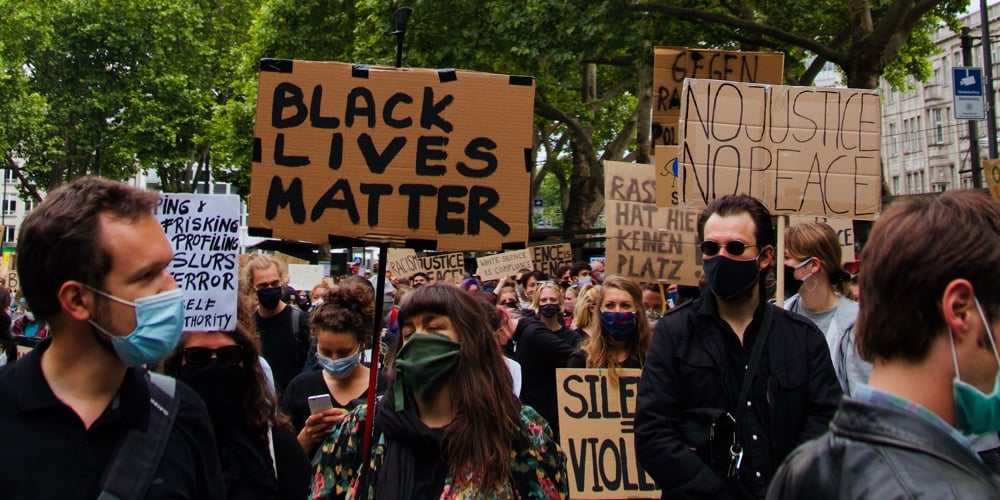Why credit unions should speak up in support of Black Lives Matter

Over the last few weeks, there have been daily, heartbreaking reminders of ways in which systemic racism continues to impact the daily lives of Black people in our country. They have left many of us, individuals and companies alike, wanting to do something—but struggling to navigate what that something is and how to best make it happen.
Yes, it’s uncomfortable, and if we speak up, we might say the wrong thing. But the very fact that white people and white-dominated businesses can choose whether or not to acknowledge the pain is in and of itself a privilege.
Plus, it’s important to remember that saying nothing is still saying something. In fact, according to Casey Boggs, a PR expert and President of ReputationUS, during times of national crisis, the worst thing an organization can do is to be silent. “If you haven’t said anything or are looking to the other folks to lead,” says Boggs, “you’re not necessarily seen as a leader, you’re just seen as an exister.”
Many Fortune 500 companies, banks included, are now speaking out in support of Black Lives Matter, and it’s time for credit unions to do the same. Why is it important for credit unions in particular to speak up?
1. Supporting the financially underserved is core to the credit union mission. Credit unions were founded to give Americans access to financial services they were denied elsewhere. The 7 Cooperative Principles, including Concern for the Community and Open and Voluntary Membership, aim to strengthen communities and empower the financially underserved.
We all know that Black Americans face formidable challenges on the financial front and have long been sidelined by mainstream financial institutions. According to research highlighted by McKinsey & Company, the average Black family has just one-tenth the family wealth of the average white family ($17,600 vs. $171,000) and nearly half of Black households (47%) are unbanked or underbanked, compared to 20% of white households.
A 2018 report from the Center for Investigative Reporting found that banks deny home loans to people of color at a rate up to five times higher than white consumers. Another 2018 study, the “Racialized Costs of Banking” reveals that bank fees in predominantly Black/Latinx neighborhoods are higher than in white neighborhoods. And research from the Economic Policy Institute shows how the many financial challenges Black Americans always face—higher unemployment rates, substantial pay and benefit gaps, lower household incomes and higher poverty rates, all of which contribute to lower levels of savings—have been exacerbated during the COVID-19 pandemic.
2. Nearly 20 million Black Americans are credit union member-owners. Data from the Federal Reserve’s Survey of Consumer Finance for 2016 suggests that about 17% percent of current credit union members in the United States are Black. That means nearly 20 million member-owners are experiencing acute levels of pain and distress, in addition to the anxiety caused by the COVID-19 pandemic. These members deserve our attention and support, and credit unions must double down on their efforts to ensure they have a supportive financial services home.
3. The future of your credit union hinges on empathy. Research from CUNA Mutual Group found that over the last five years, multicultural consumers drove 61% of credit union growth. Simply put, consumers of color are the face and future of the credit union movement.
In a recent episode of the Remarkable Credit Union podcast, Edgar Hernandez, Senior Multicultural Strategy Manager at CUNA Mutual Group, pointed out that while multinational companies understand the opportunity presented by a marketing approach grounded in empathy and multiculturalism, “the credit union industry has been a little bit insulated. They have kind of fallen behind. I think they’re starting to realize that the numbers are changing.”
Hernandez stresses that “equity is about empathy.” Gigi Hyland, Executive Director of The National Credit Union Foundation (NCUF), elaborates on the power of empathy and the importance of putting it at the center of the credit union business model. Hyland says, “Make the financial wellbeing of your members and employees the center of your strategy. That is where you start. That is your why. That is your path forward. That is your opportunity.”
Imagine the power we could tap into if we committed to learning about each other and finding common ground.
What next?
The credit union movement has shown it’s committed to making a difference—but there is more work to do. Credit unions currently top banks in three critical areas: percentage of Black members (17% vs. 12.8%), branch access (6.3% vs. 5.3%) and providing mortgages to Black members (6.6% vs. 5.2%).
The African-American Credit Union Coalition (AACUC) was founded to increase opportunities for African Americans as both credit union members and employees, and the African American Credit Union Initiative has helped member credit unions tackle a range of challenges, including limited access to technology, payment options and online banking services.
But the credit union industry, like so many other industries, still has ample room for improvement. There have historically been very few Black men and women in credit union leadership roles and even today, of the 5,800 credit unions in the U.S., only 165—less than 3%—are led by a Black CEO.
Then there are the realities that payday lenders, pawnshops and check-cashing shops are still common sights in low-income Black neighborhoods, and that Black small business owners are much more likely than white business owners to struggle with acquiring capital. These realities illustrate that credit unions still have more to do when it comes to meeting the financial needs of this underserved population.
Yes, the challenges of racism are daunting. Making a public statement about Black Lives Matter won’t solve those challenges, but as they say, a journey of a thousand miles begins with a single step. Here are some sample responses and ideas from the financial industry for you and your credit union to consider:
- This message from OnPoint Community Credit Union’s CEO outlines how they intend to support their local Black community and emphasizes the credit union foundational ideal of “people helping people.”
- The CFO of Citi published a very heartfelt blog post about his own personal experience and the importance of speaking out.
- Among many resources and emails dedicated to supporting the Black community, Ellevest shared this refreshingly practical article, 5 Ways to Use Your Money to Support Black Lives.
- The CEO & Founder of Betterment sent an email and published this blog post to emphasize the importance of leaning into change and to announce how Betterment plans to do this.
- In its blog, NCUF asks, What Do We Stand For?, advocating for Financial Democracy and “rebranding” the 7 Cooperative Principles.
As you consider your own approach, start with this helpful advice from Filene and also think about these key questions:
- What is the core message your members and community need to hear from you right now?
- How can you most effectively adapt this message to your marketing channels, including social media, your website, and email communications?
- Do you need to revisit the channels you’re using to connect with Black communities?
- Can you alter your procurement policies to say that, all else being equal, you will select vendors owned by African Americans? This has been a standard policy for decades for many corporations and parts of government.
- How can your giving efforts address the needs of your local Black communities?
- What local Black-owned businesses can you encourage your members to support?
There’s a lot of work to do, but we can’t roll up our sleeves until we let our member-owners know where we stand. As Andréa Ranae, a leadership coach and teacher has said, “Antiracism is not an identity or a checklist; it’s a practice.”
Let’s all start living that practice together, today.

